Smallpox and infectious diseases. Later, general, acute
By the turn of the century, the smallpox hospital ships Atlas, Endymion and Castalia, were in poor condition, expensive to maintain and limited in how many patients they could hold. The Metropolitan Asylums Board (MAB) decided to replace them with a new, large, smallpox hospital on the 315 acres of land it owned at Long Reach.
Building work started in 1901, just as another smallpox epidemic began, so temporary smallpox hospitals - Long Reach Hospital and Orchard Hospital - were erected early in 1902 to the north of the new hospital.
Between them, the three 'River Hospitals' had just over 2000 smallpox beds; Gore Farm Hospital, used for recovering patients, had an additional 1000 beds. The old hospital ships were disposed of shortly afterwards, but the pier-side buildings were retained as an additional small self-contained hospital of 50 beds for sporadic cases of smallpox.
The 1901-1902 smallpox epidemic was the last major outbreak in London and, in 1910, it was decided to reorganise the service. Joyce Green Hospital became a fever hospital, treating cases of scarlet fever and diphtheria (and, later, measles and whooping cough). With no antibiotics available, morbidity was high, even among the nursing staff.
It remained a fever hospital for the duration of WW1. In July 1918 over a thousand refugees from Eastern Europe were admitted, suspected of having had contact with smallpox (German prisoners-of-war from the nearby Dartford War Hospital helped to prepare the accommodation for their arrival). In the event, only two cases of smallpox were found, but all were examined and revaccinated. In October of the same year the epidemic of Spanish flu occurred, as well as a major outbreak of scarlet fever.
In 1919 , with the encouragement of the Medical Superintendent, the 254 acres of Hospital grounds were planted with many shrubs and trees. The Hospital became a centre of plant propagation, supplying the other institutions belonging to MAB.
In 1922 there was a minor epidemic of smallpox in which 107 patients died. After that the Hospital was more or less empty, but it survived the threat of demolition and was instead repaired and rebuilt, with new isolation units. In 1926 electric lighting was installed at a cost of £10,500. In 1928 there was an epidemic of variola minor, mainly in unvaccinated children (this was a milder type of smallpox which had a mortality rate of less than 1%. compared with variola major which had a mortality rate of 30%).
In 1930 the LCC took over administration of the Hospital. The River Ambulance Service was closed, land ambulances being favoured by the new regime. Joyce Green Hospital lay empty. It was never used for smallpox again, as the newly rebuilt Long Reach Hospital was reserved for this purpose.
During WW2 Joyce Green became a general hospital as part of the Emergency Medical Service. The number of beds was increased from 986 to 1900. Staff accommodation was also increased. On 1st June 1940 the Hospital received 160 casualties from Dunkirk, including 24 French and 4 Zouaves. Later in the year 113 casualties were brought from the County Hospital in West Hill, Dartford, which had received a direct hit during a bombing raid. During the war specialist units were established, including a 'special dermatological unit' and three X-ray Departments. From January until September 1944 part of the site was used as the Netherlands Military Hospital (during this period 10,054 patients were treated and the Ministry of Health send a bill for £4310, based on 9 shillings (45p) per day per in-patient, to the Netherlands Ministry of War). Only minor damage to the Hospital buildings occurred during the war, despite 26 bombing incidents involving 64 high explosive bombs, 3 oil bombs and 200 incendiary bombs (these doing most damage to the wooden hutted Long Reach and Orchard Hospitals). By the end of the war in 1945 only 428 patients remained.
In 1948 the Hospital joined the NHS under the control of the Dartford Hospital Management Committee.
In February 1953 the River Thames flooded Long Reach Hospital and the waters reached the north gate of Joyce Green Hospital. An adjacent fireworks factory was also flooded, causing a chemical reaction resulting in a fire and three explosions. Five hundred panes of glass were broken at the Joyce Green Hospital.
In 1953 it became a centre for the treatment of poliomyelitis. By this time there were 341 beds, including those at the Orchard Hospital.
In 1959 the wards were modernized and divided into sections; the central stoves were removed. New kitchen and sterlizing equipment were installed. In the same year the Southern Hospital closed and its patients and staff were transferred to Joyce Green Hospital. A swimming pool was built to commemorate the amalgamation of the two Hospitals; it opened in 1961.
In 1962 lifts were installed to the wards and covered corridors built outside Blocks 1-4. A new twin operating theatre opened in 1963. A Cervical Cytology Unit was established in 1966, as well as a 'Well Woman' Clinic, the first in the country. A new group pharmacy was built in 1967, the old one becoming new accommodation for the porters. A new Psychiatry Unit with 54 beds for short-term patients opened in 1969 - two blocks were joined together at the cost of £77,000 - and patients from West Hill Hospital were transferred to the new unit.
In 1970 a new unit for mentally handicapped patients opened (this later became Orchard House) and work began on a new £60,000 paediatric block. The Postgraduate Centre for medical education opened in 1972.
In 1974 the Denton Hospital in Gravesend closed with the patients being transferred to Joyce Green.
By 1985 the Hospital had 515 beds. St James Hospital in Gravesend closed that same year and again the patients were transferred to Joyce Green. They were housed in St James House until 1992, when it was deemed unsuitable for the elderly and was closed. The patients were transferred back to Gravesend - to Wombwell Hall.
In 1991, in an arson attack, the laundry building was burned down. The fire spread to the boiler room and threatened to damage a nearby ward; the 38 elderly patients were evacuated. Over £2m of damage was cause and half the linen supplies lost.
In 1992 a Day Care Unit for minor surgery opened and, in 1996, an Accident & Emergency Department. The Royal College of Anaesthetists had become concerned that seriously ill patients treated at the A&E Department at West Hill Hospital were being transferred to wards at Joyce Green.
By 2000 the Hospital had 363 general beds and 55 psychiatric beds. It closed in September when the newly built Darent Vally Hospital opened.
Present status (March 2009)
The Hospital has been totally demolished and the area is being comprehensively redeveloped, mainly as housing for The Bridge, a new development by George Wimpey, the Homes and Communities Agency and Moat.
The perimeter roads are being named after bridge designers - to the north there is Rennie Drive and Binnie Road, and Brunel Way and Halcrow Avenue at the south.

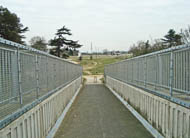
The pedestrian footbridge over University Way is situated roughly on the line of the original entrance drive of the Hospital.
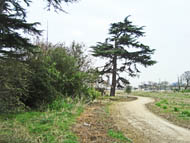
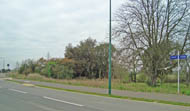
Mature trees are found at the south of the site and along Brunel Way.
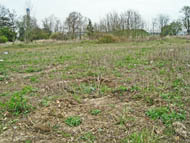
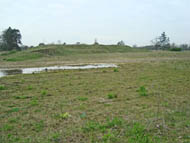
An old foundation and an unexplained mound on the south-east corner of the site (left), and another unexplained mound on the north-east corner (right).
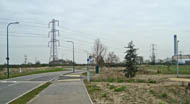
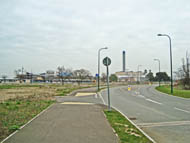
Looking east along the north perimeter road (Binney Way).
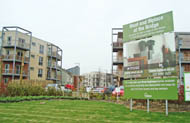
The housing on Marsh Street in The Bridge. The 2-, 3- and 4-bedroomed houses are eco-friendly.
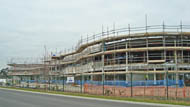
The 'Learning and Community Campus' under construction north of the busway.
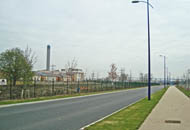
Looking east on the busway - the chimney of Littlebrook power station and the Queen Elizabeth Bridge can be seen in the distance.
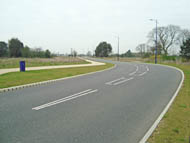
Looking south along the fast-track busway which links the site to Dartford and Greenhithe.
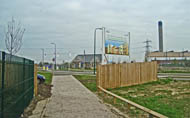
The central drive of the development and sales office. On the right is the chimney of Littlebrook power station.
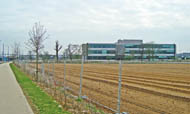
The Nucleus Business Innovation Centre.

A building site to the north of the busway, part of The Bridge housing development.
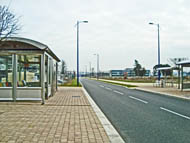
Looking east along the busway. The new shelters will eventually be used by the residents of The Bridge, but currently stand in splendid isolation.
Burne J 1999 Peace and war at Joyce Green Hospital 1914-1948. Bygone Kent 24, 197-205.
Payne F 2001 Joyce Green and the River Hospitals. Self-published.
http://joycegreenhospitalrevisited.blogspot.com
www.aim25.ac.uk
www.bbc.co.uk
www.bexley.gov.uk
www.dartford.gov.uk
www.dartfordhospitalhistories.org.uk
www.dvh.nhs.uk
www.geograph.org.uk
www.kent.gov.uk
www.templehilltrust.org.uk
www.workhouses.org.uk
Return to home page